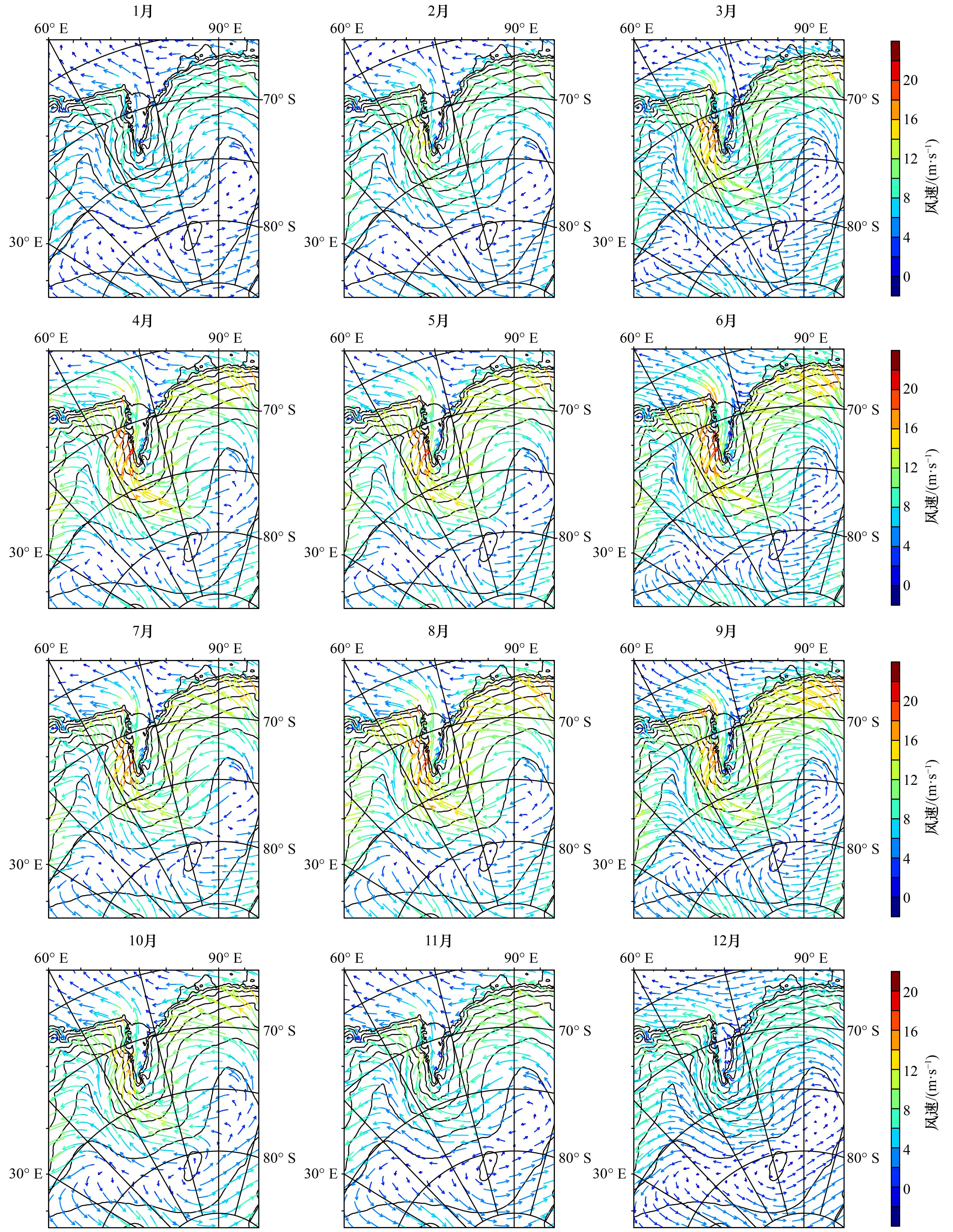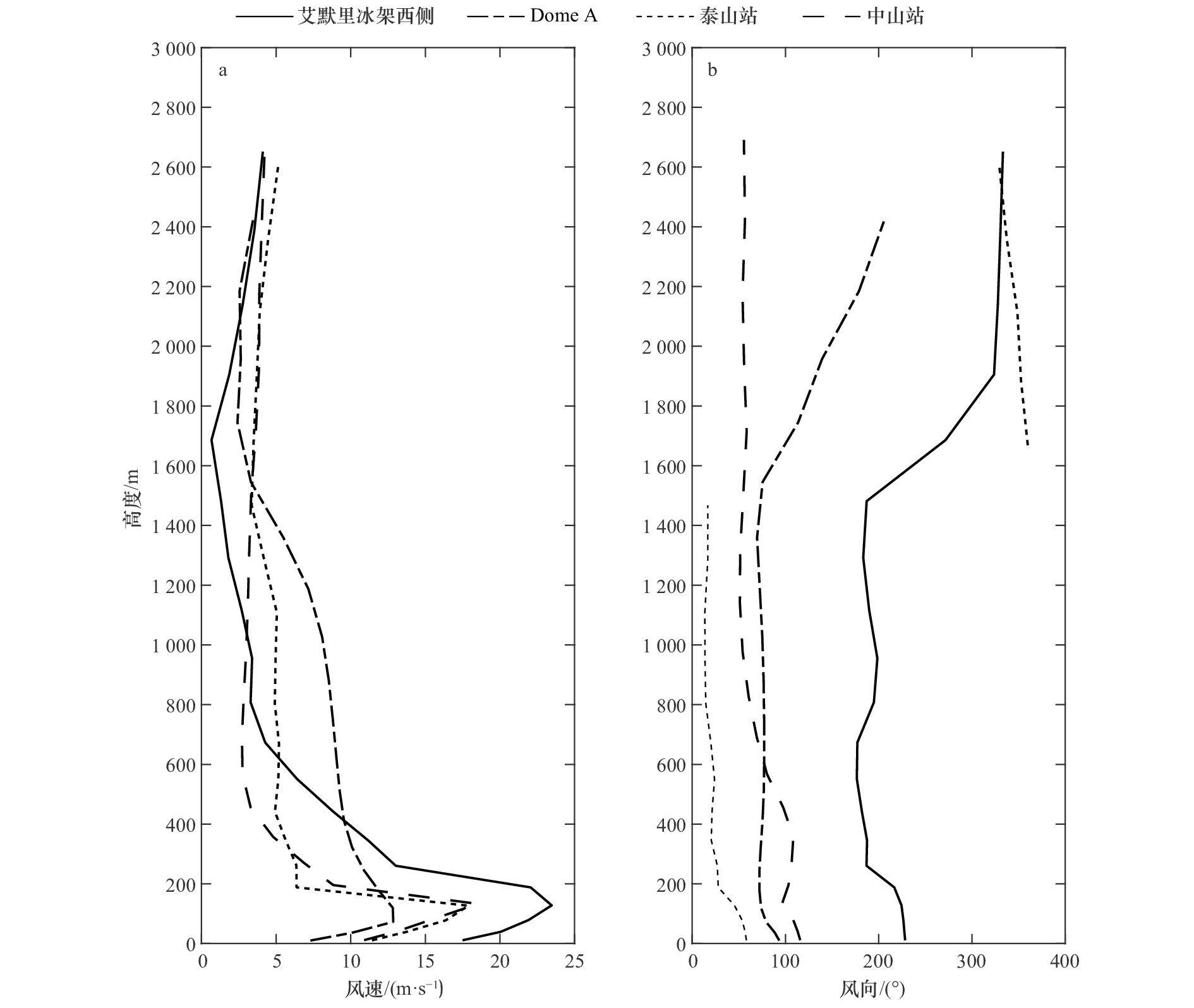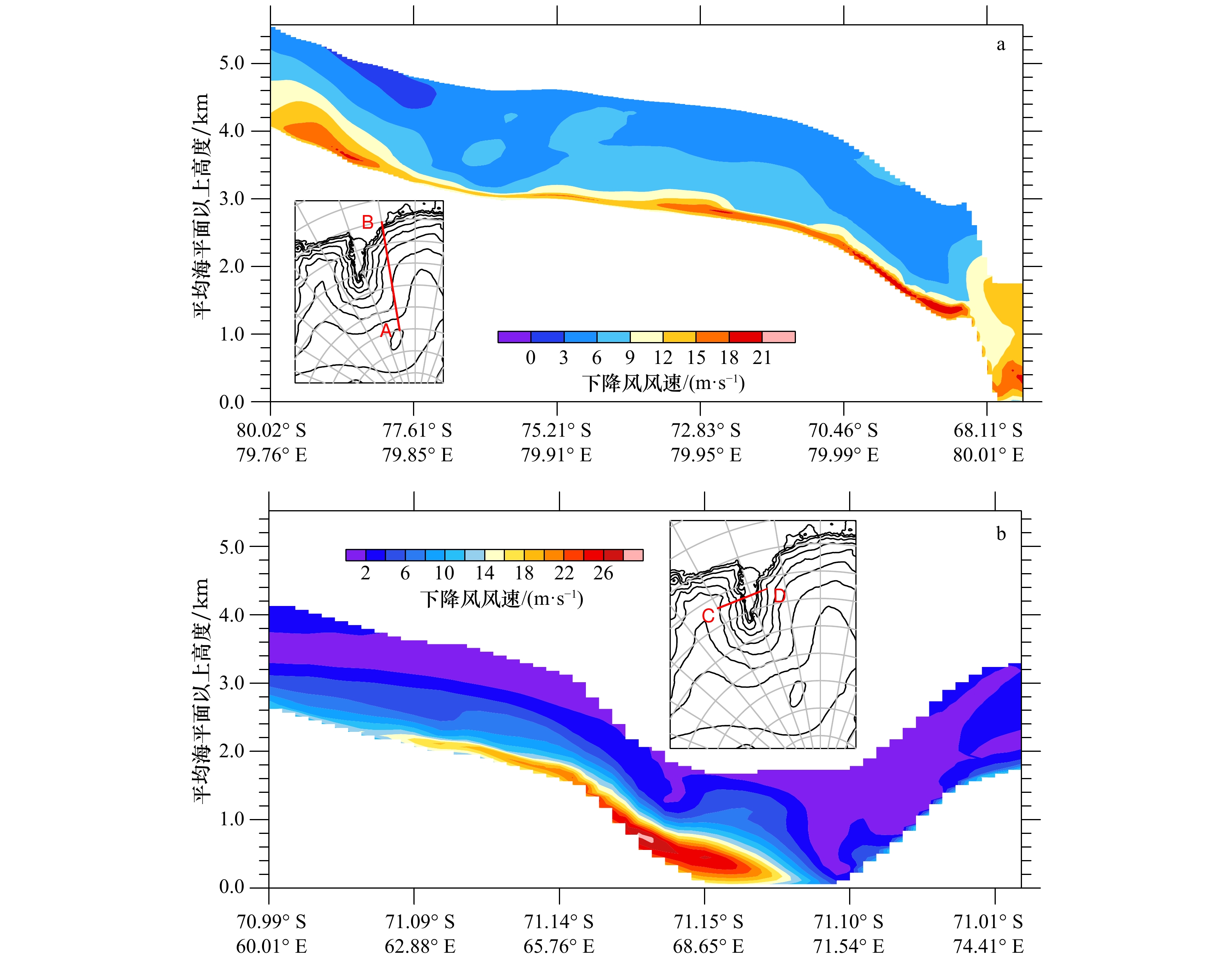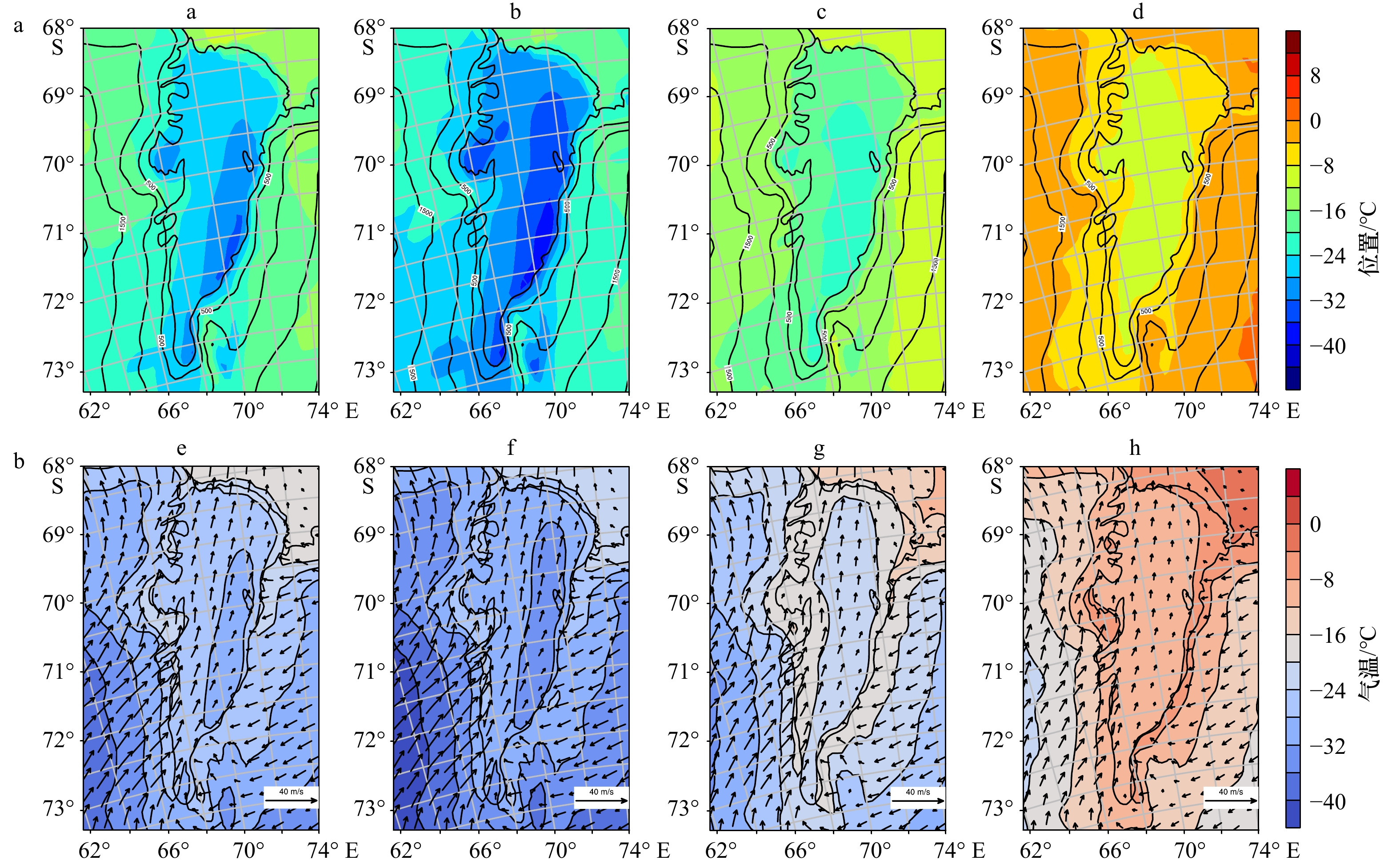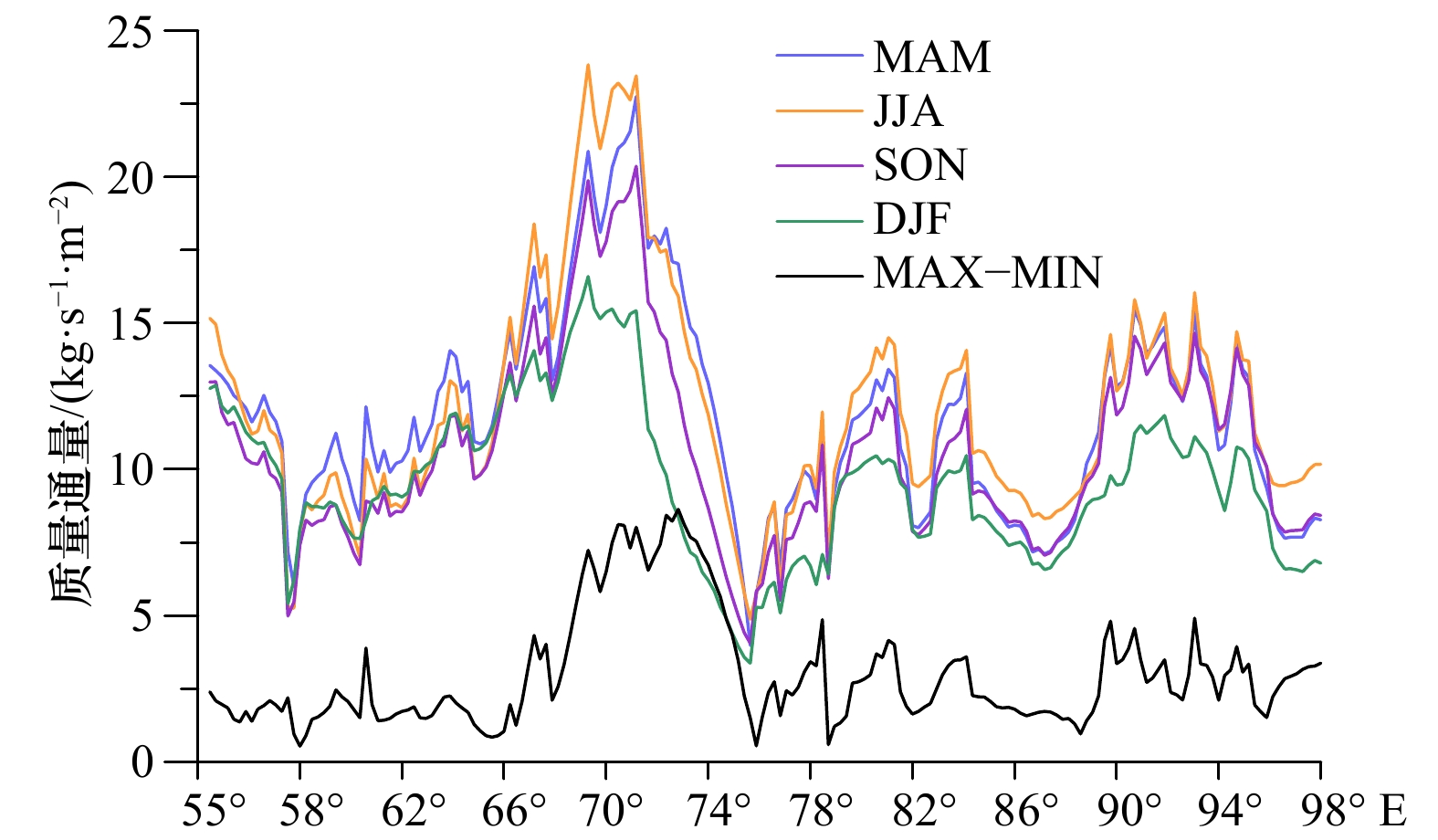Characteristics of katabatic winds from Dome A to the coast of Prydz Bay, Antarctica
-
摘要: 本文利用我国极地数值天气预报系统和美国南极中尺度预报系统的存档数据,分析了Dome A至普里兹湾沿岸地区下降风风场的时空分布和大气质量通量,给出了该地区下降风的基本特点。该地区下降风受南极冰盖地形影响强烈,艾默里冰架西侧等陡峭地区风速总体较大;下降风随季节变化较大,冬季的下降风较强。强下降风在前进过程中有绝热增温现象,并给艾默里冰架西部带来近表层升温。下降风风速最大处位于地面以上约100~200 m高度,风速较大地区的下降风在垂直方向上分布较为深厚。下降风在普里兹湾沿岸的表层大气质量通量在时空分布上极不均匀,艾默里冰架西侧的下降风气流较强时,普里兹湾海域有较多的中尺度气旋活动。下降风引发普里兹湾中尺度气旋旋生的过程值得关注,需进一步研究下降风引发中尺度气旋的机理。Abstract: Using archived data from Chinese Polar Numerical Weather Forecasting System (PNWFS) and America Antarctic Mesoscale Prediction System, the spatial and temporal distribution of katabatic winds and air mass flux from Dome A to the coast of Prydz Bay are analyzed, and basic characteristics of katabatic winds in the region are depicted. It is found that the katabatic winds in this area is strongly affected by the terrain of the Antarctica ice sheet. Steep terrain such as the western side of the Amery Ice Shelf sees stronger katabatic winds than smooth terrain does; and the katabatic winds vary greatly with the season for temporal distribution with stronger winds in winter. Adiabatic warming, which can be found in the area where strong katabatic winds flow, causes increasing of near surface temperature at the Amery Ice Shelf. The maximum katabatic wind speed zone is located at a height of about 100 m to 200 m above the ground. Katabatic winds extents to higher altitudes while surface winds are stronger. The surface air mass flux of the katabatic winds along the coast of the Prydz Bay is extremely uneven in spatial and temporal distribution. Strong katabatic winds in the Amery Ice Shelf are linked to more mesoscale cyclone activities in the Prydz Bay waters. The process of mesoscale cyclones induced by katabatic winds in the Prydz Bay is worthy of attention, thus the mechanism of cyclogenesis forced by katabatic winds needs further notice.
-
Key words:
- Antarctica /
- katabatic winds /
- atmospheric surface mass flux /
- mesoscale cyclone
-
图 5 南极冬季Dome A附近A点(80.0°S, 80.0°E)至大陆沿岸B点(67.5°S, 80.0°E) (a)和艾默里冰架西侧C点(71.0°S, 60.0°E)至东侧D点(71.0°S, 75.0°E) (b)下降风垂向剖面图
Fig. 5 The profile of Antarctic winter katabatic winds of Dome A (80.0°S, 80.0°E) to coast (67.5°S, 80.0°E) (a) and west (71.0°S, 60.0°E) to east (71.0°S, 75.0°E) of Amery Ice Shelf (b)
图 6 南极Dome A至普里兹湾沿岸地区2014−2016年季节平均的表层大气质量通量
a. 3−5月;b. 6−8月;c. 9−11月;d. 12月至翌年2月
Fig. 6 Seasonally mean of surface air mass flux from the Dome A to the coast of Prydz Bay, Antarctica, during 2014 to 2016
a. March to May; b. June to August; c. September to November; d. December to February of the following year
图 7 南极艾默里冰架2014−2016年季节平均的位温(a−d)和2 m气温场和10 m风场(e−h)
a, e. 3−5月;b, f. 6−8月;c, g. 9−11月;d, h. 12月至翌年2月
Fig. 7 Seasonally mean of potential temperature (a−d) and 2 m air temperature and 10 m wind (e−h) of Amery Ice Shelf, Antarctica, during 2014 to 2016
a, e. March to May; b, f. June to August; c, g. September to November; d, h. December to February of the following year
图 8 南极普里兹湾沿岸季节平均表层大气质量通量经向分布
MAM:3−5月;JJA:6−8月;SON:9−11月;DJF:12月至翌年2月;MAX−MIN:季节平均最大值与最小值之差
Fig. 8 Seasonally mean of longitudinal distribution of surface air mass flux along the coast of Prydz Bay, Antarctica
MAM: March to May; JJA: June to August; SON: September to November; DJF: December to February of the following year; MAX−MIN: difference of maximum and minimum seasonally mean
图 9 南极中山站附近区域1979−2013年平均气旋活动分布(引自文献[20])
a. 9−11月;b. 12月至翌年2月;c. 3−5月;d. 6−8月。星号表示中山站的位置,红点表示气旋数量≥40个;紫点表示30个≤气旋数量<40个;黄点表示20个≤气旋数量<30个;绿点表示10个≤气旋数量<20个;蓝点表示1个≤气旋数量<10个
Fig. 9 The distribution of cyclones number density near the Zhongshan Station, Antarctica (cited from reference [20])
a. September to November; b. December to February of the following year; c. March to May; d. June to August. The asterisk indicate the location of Zhongshan Station, and the red dots indicate the number of cyclones ≥40; the purple dots indicate 30≤ number of cyclones <40; the yellow dots indicate 20≤ number of cyclones <30; the green dots indicate 10≤number of cyclones <20; the blue dots indicate 1 ≤ number of cyclones <10
-
[1] Bromwich D H, Parish T R, Pellegrini A, et al. Spatial and temporal characteristics of the intense katabatic winds at Terra Nova Bay, Antarctica[M]//Bromwich D H, Stearns C R. Antarctic Meteorology and Climatology: Studies Based on Automatic Weather Stations. Washington D. C.: Antarctic Research Series, 1993, 61: 47−68. [2] Yamada K, Hirasawa N. Analysis of a record-breaking strong wind event at Syowa station in January 2015[J]. Journal of Geophysical Research: Atmospheres, 2018, 123(24): 13643−13657. [3] Parish T R, Cassano J J. Diagnosis of the katabatic wind influence on the wintertime Antarctic surface wind field from numerical simulations[J]. Monthly Weather Review, 2003, 131(6): 1128−1139. doi: 10.1175/1520-0493(2003)131<1128:DOTKWI>2.0.CO;2 [4] 孙启振, 张林, 张占海, 等. 南极中山站夏季下降风数值模拟个例研究[J]. 海洋学报, 2016, 38(3): 71−81.Sun Qizhen, Zhang Lin, Zhang Zhanhai, et al. Numerical simulation of summer katabatic wind at Zhongshan Station, Antarctica: A case study[J]. Haiyang Xuebao, 2016, 38(3): 71−81. [5] Ball F K. The theory of strong katabatic winds[J]. Australian Journal of Physics, 1956, 9(3): 373−386. doi: 10.1071/PH560373 [6] Carrasco J F, Bromwich D H, Monaghan A J. Distribution and characteristics of mesoscale cyclones in the Antarctic: Ross Sea eastward to the Weddell Sea[J]. Monthly Weather Review, 2003, 131(2): 289−301. doi: 10.1175/1520-0493(2003)131<0289:DACOMC>2.0.CO;2 [7] Bromwich D H, Steinhoff D F, Simmonds I, et al. Climatological aspects of cyclogenesis near Adélie Land Antarctica[J]. Tellus A: Dynamic Meteorology and Oceanography, 2011, 63(5): 921−938. doi: 10.1111/j.1600-0870.2011.00537.x [8] Parish T R, Bromwich D H. Continental-scale simulation of the Antarctic katabatic wind regime[J]. Journal of Climate, 1991, 4(2): 136−146. [9] Renfrew I A, Anderson P S. Profiles of katabatic flow in summer and winter over Coats Land, Antarctica[J]. Quarterly Journal of the Royal Meteorological Society, 2006, 132(616): 779−802. doi: 10.1256/qj.05.148 [10] Parish T R, Bromwich D H. The surface windfield over the Antarctic ice sheets[J]. Nature, 1987, 328(6125): 51−54. doi: 10.1038/328051a0 [11] Parish T R, Bromwich D H. Reexamination of the near-surface airflow over the Antarctic continent and implications on atmospheric circulations at high southern latitudes[J]. Monthly Weather Review, 2007, 135(5): 1961−1973. doi: 10.1175/MWR3374.1 [12] Vihma T, Tuovinen E, Savijärvi H. Interaction of katabatic winds and near-surface temperatures in the Antarctic[J]. Journal of Geophysical Research: Atmospheres, 2011, 116(D21): D21119. doi: 10.1029/2010JD014917 [13] Parish T R, Bromwich D H. A case study of Antarctic katabatic wind interaction with large-scale forcing[J]. Monthly Weather Review, 1998, 126(1): 199−209. doi: 10.1175/1520-0493(1998)126<0199:ACSOAK>2.0.CO;2 [14] Bromwich D H. Mesoscale cyclogenesis over the southwestern Ross Sea linked to strong katabatic winds[J]. Monthly Weather Review, 1991, 119(7): 1736−1753. doi: 10.1175/1520-0493(1991)119<1736:MCOTSR>2.0.CO;2 [15] Carrasco J F, Bromwich D H. A katabatic-wind-forced mesoscale cyclone development over the Ross Ice Shelf near Byrd Glacier during summer[J]. Antarctic Journal of the United States, 1993, 28(5): 285−288. [16] Zhou Chunxia, Zheng Lei, Sun Qizhen, et al. Amery Ice Shelf surface snowmelt detected by ASCAT and Sentinel-1[J]. Remote Sensing Letters, 2019, 10(5): 430−438. doi: 10.1080/2150704X.2018.1553317 [17] Parish T R. On the role of Antarctic katabatic winds in forcing large-scale tropospheric motions[J]. Journal of the Atmospheric Sciences, 1992, 49(15): 1374−1385. doi: 10.1175/1520-0469(1992)049<1374:OTROAK>2.0.CO;2 [18] Ding Minghu, Xiao Cunde, Li Chuanjin, et al. Surface mass balance and its climate significance from the coast to Dome A, East Antarctica[J]. Science China: Earth Sciences, 2015, 58(10): 1787−1797. doi: 10.1007/s11430-015-5083-9 [19] Ding Minghu, Yang Diyi, Van Den Broeke M, et al. The surface energy balance at Panda 1 station, princess Elizabeth land: a typical katabatic wind region in East Antarctica[J]. Journal of Geophysical Research: Atmospheres, 2020, 125(3): e2019JD030378. doi: 10.1029/2019JD030378 [20] 秦听, 魏立新, 李珵. 我国南极科考站附近气旋的特征分析[J]. 海洋学报, 2017, 39(5): 44−60.Qin Ting, Wei Lixin, Li Cheng. The statistic and variance of cyclones enter in scientific investigation station of China in Antarctic[J]. Haiyang Xuebao, 2017, 39(5): 44−60. [21] 孙虎林, 秦听, 魏立新, 等. 中国南极考察航线上气旋大风过程统计分析[J]. 海洋学报, 2020, 42(1): 54−66.Sun Hulin, Qin Ting, Wei Lixin, et al. A statistical analysis on cyclonic gale processes along Chinese Antarctic research expedition routes[J]. Haiyang Xuebao, 2020, 42(1): 54−66. [22] Kobayashi S I. Snow transport by katabatic winds in Mizuho Camp area, East Antarctica[J]. Journal of the Meteorological Society of Japan. Ser. II, 1978, 56(2): 130−139. doi: 10.2151/jmsj1965.56.2_130 [23] Scarchilli C, Frezzotti M, Grigioni P, et al. Extraordinary blowing snow transport events in East Antarctica[J]. Climate Dynamics, 2010, 34(7/8): 1195−1206. [24] Chambers S D, Preunkert S, Weller R, et al. Characterizing atmospheric transport pathways to Antarctica and the remote southern ocean using radon-222[J]. Frontiers in Earth Science, 2018, 6: 190. doi: 10.3389/feart.2018.00190 [25] Hines K M, Bromwich D H. Development and testing of polar weather research and forecasting (WRF) model. Part I: Greenland ice sheet meteorology[J]. Monthly Weather Review, 2008, 136(6): 1971−1989. doi: 10.1175/2007MWR2112.1 [26] Bromwich D H, Otieno F O, Hines K M, et al. Comprehensive evaluation of polar weather research and forecasting model performance in the Antarctic[J]. Journal of Geophysical Research: Atmospheres, 2013, 118(2): 274−292. doi: 10.1029/2012JD018139 [27] 孙启振, 丁卓铭, 沈辉, 等. 我国极地数值天气预报系统的初步建立与应用[J]. 海洋预报, 2017, 34(4): 1−10. doi: 10.11737/j.issn.1003-0239.2017.04.001Sun Qizhen, Ding Zhuoming, Shen Hui, et al. Polar numerical weather prediction system: Preliminary establishment and application[J]. Marine Forecasts, 2017, 34(4): 1−10. doi: 10.11737/j.issn.1003-0239.2017.04.001 [28] Powers J G, Manning K W, Bromwich D H, et al. A decade of Antarctic science support through AMPS[J]. Bulletin of the American Meteorological Society, 2012, 93(11): 1699−1712. doi: 10.1175/BAMS-D-11-00186.1 [29] Powers J G, Monaghan A J, Cayette A M, et al. Real-time mesoscale modeling over Antarctica: The Antarctic mesoscale prediction system[J]. Bulletin of the American Meteorological Society, 2003, 84(11): 1533−1546. doi: 10.1175/BAMS-84-11-1533 [30] Wille J D, Bromwich D H, Cassano J J, et al. Evaluation of the AMPS boundary layer simulations on the Ross Ice Shelf, Antarctica, with unmanned aircraft observations[J]. Journal of Applied Meteorology and Climatology, 2017, 56(8): 2239−2258. doi: 10.1175/JAMC-D-16-0339.1 [31] Kirchgaessner A, King J, Gadian A. The representation of Föhn events to the east of the Antarctic Peninsula in simulations by the Antarctic mesoscale prediction system[J]. Journal of Geophysical Research: Atmospheres, 2020, 124(24): 13663−13679. doi: 10.1029/2019JD030637 [32] Dittmann A, Schlosser E, Masson-Delmotte V, et al. Precipitation regime and stable isotopes at Dome Fuji, East Antarctica[J]. Atmospheric Chemistry and Physics, 2006, 16(11): 6883−6900. [33] Hines K M, Bromwich D H, Wang S H, et al. Microphysics of summer clouds in central West Antarctica simulated by the polar weather research and forecasting model (WRF) and the antarctic mesoscale prediction system (AMPS)[J]. Atmospheric Chemistry and Physics, 2019, 19(19): 12431−12454. doi: 10.5194/acp-19-12431-2019 [34] Francis D, Eayrs C, Cuesta J, et al. Polar cyclones at the origin of the reoccurrence of the Maud Rise Polynya in austral winter 2017[J]. Journal of Geophysical Research: Atmospheres, 2019, 124(10): 5251−5267. doi: 10.1029/2019JD030618 [35] Massom R A, Harris P T, Michael K J, et al. The distribution and formative processes of latent-heat polynyas in East Antarctica[J]. Annals of Glaciology, 1998, 27: 420−426. doi: 10.3189/1998AoG27-1-420-426 [36] 李群, 吴辉碇, 张璐. 普里兹湾海冰季节性变化的高分辨率数值模拟[J]. 海洋学报, 2011, 33(5): 32−38.Li Qun, Wu Huiding, Zhang Lu. Fine-scale simulation of the seasonal variations of sea ice cover in the Prydz bay, Antarctic[J]. Haiyang Xuebao, 2011, 33(5): 32−38. [37] Heinemann G, Glaw L, Willmes S. A satellite-based climatology of wind-induced surface temperature anomalies for the Antarctic[J]. Remote Sensing, 2019, 11(13): 1539. doi: 10.3390/rs11131539 [38] Uotila P, Vihma T, Pezza A B, et al. Relationships between Antarctic cyclones and surface conditions as derived from high-resolution numerical weather prediction data[J]. Journal of Geophysical Research: Atmospheres, 2011, 116(D7): D07109. [39] Verezemskaya P, Tilinina N, Gulev S, et al. Southern ocean mesocyclones and polar lows from manually tracked satellite mosaics[J]. Geophysical Research Letters, 2017, 44(15): 7985−7993. doi: 10.1002/2017GL074053 [40] Carrasco J F, Bromwich D H. A case study of katabatic wind-forced mesoscale cyclogenesis near Byrd Glacier[J]. Antarctic Journal of the United States, 1991, 26(5): 258−261. [41] Carrasco J F, Bromwich D H. Mesoscale cyclogenesis dynamics over the southwestern Ross Sea, Antarctica[J]. Journal of Geophysical Research: Atmospheres, 1993, 98(D7): 12973−12995. doi: 10.1029/92JD02821 [42] Klein T, Heinemann G. Interaction of katabatic winds and mesocyclones near the eastern coast of Greenland[J]. Meteorological Applications, 2002, 9(4): 407−422. doi: 10.1017/S1350482702004036 [43] Klein T, Heinemann G. On the forcing mechanisms of mesocyclones in the eastern Weddell Sea region, Antarctica: Process studies using a mesoscale numerical model[J]. Meteorologische Zeitschrift, 2001, 10(2): 113−122. doi: 10.1127/0941-2948/2001/0010-0113 [44] Heinemann G, Klein T. Simulations of topographically forced mesocyclones in the Weddell Sea and the Ross Sea region of Antarctica[J]. Monthly Weather Review, 2003, 131(2): 302−316. doi: 10.1175/1520-0493(2003)131<0302:SOTFMI>2.0.CO;2 [45] Heinemann G, Saetra Ø. Workshop on polar lows[J]. Bulletin of the American Meteorological Society, 2013, 94(9): ES123−ES126. [46] Spengler T, Claud C, Heinemann G. Polar low workshop summary[J]. Bulletin of the American Meteorological Society, 2017, 98(6): ES139−ES142. doi: 10.1175/BAMS-D-16-0207.1 [47] Heinemann G, Claud C, Spengler T. Polar low workshop[J]. Bulletin of the American Meteorological Society, 2019, 100(2): ES89−ES92. doi: 10.1175/BAMS-D-18-0103.1 [48] 解思梅, 郝春江, 梅山, 等. 南极普里兹湾气旋的生消发展[J]. 海洋学报, 2002, 24(6): 11−19.Xie Simei, Hao Chunjiang, Mei Shan, et al. Cyclone formation−development in the Antarctic Prydz Bay[J]. Haiyang Xuebao, 2002, 24(6): 11−19. -





 下载:
下载:

